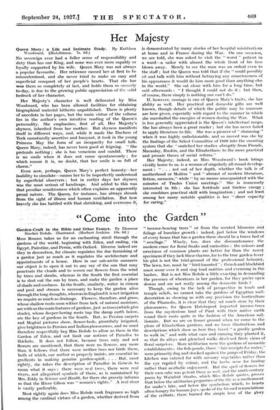" Come into the Garden "
Garden-Craft in the Bible and Other Essays. By Eleanour Sinclair -Rohde. -Illustrated. (Herbert Jenkins. 10s. 6d.) MISS it0HDE takes us for an enchanting stroll through the gardens of the world, beginning with Eden, and ending, via Egypt, Palestine; 'and Persia, with Oxford. Diverse indeed are they in dedoration, for climate regulates the due furnishing of a garden just as much as it regulates the architecture and appointments of a house: Here in our sub-arctic summers our object is to open it out to any ray of the sun that may penetrate the clouds and to screen our flowers from the wind by trees and shrubs, whereas in the South the first essential is to shut out the sun by trees, and make the garden a place Of shade and coolness. In the South, similarly, wafer in cistern and pool and stream is necessary to keep the garden alive through the long droughts, whereas in England it is not irrigation we require so much as drainage. Flowers, therefore, and grass, whose shallow roots soon wither from lack of natural moisture, are with us the main features of gardens, just as trees (which give shade), whose deeper-boring roots tap the damp earth below, are the key of gardens in the South. But, as Persian carpets and Moghul pictures show, flower-beds, plentifully irrigated, give brightness to Persian and Indian pleasaunces, and we must therefore respectfully beg Miss Rohde to allow us these in the Garden of Eden, and not limit our notions of Paradise to thickets. It does not follow, because trees only and not flowers are mentioned, that there were no flowers, any more than it follows that there were neither bees nor birds there, both of which, our author so properly insists, are essential in- gredients in making genuine garden-spirit. . . . But, most rightly, she takes the description of Paradise in Genesis to mean what it says : there were real trees, there were real rivers, not allegorical symbols of them, as is maintained by Mrs. Eddy in Science and Health, for there she gravely informs us that the River Gihon was " women's rights." A real river is vastly preferable.
Most rightly again does Miss Rohde rank fragrance as high among the cardinal virtues of a garden, whether derived from
" incense-bearing trees " or from the scented blossoms .anni foliage of humbler growth : indeed, just below the windoWs of every. house that has a garden there should be a brave bed of " smellage." Wisely, too, does she discountenance the modern craze for floral freaks and curiosities : the colotirsan0 sweetness of common plants are, better far than the rarest speciMens if they lack these charms, for to the true garden-loVe his plot is not the trial-ground of the professional. botanist. The lawn, too, must be " bird-haunted" ; thrush and blackbird must scour over it and sing loud mattins and evensong in the bushes. But is not Miss Rohde a little exacting in demanding the presence of wheatears in her garden, for they prefer 'open downs and are not really among the domestic birds ?
Though, owing to the lack of perspective in tomb and temple reliefs, we cannot take the gardens of Egyptian wall- decoration as showing us with any precision the horticulture of the Pharaohs, it is clear that they set much store by their pleasaunces, for Queen Hatshepsut imported incense-trees from the mysterious land of Punt with their native earth round their roots :quite in the fashion of the American mil- lionaire. But we are on firmer ground when we come to the plans of Elizabethan gardens, and we have illustrations and descriptions which show us how they loved." a goodly garden to walk in," and with what care and cunning they planted it, so that its alleys and pleached walks disclosed fresh views of floral surprises. More utilitarian were the gardens of monastic establishments : the fish-ponds, those fair receipts for water," were primarily dug and stocked against the pangs of Friday, the kitchen was catered for with savoury vegetables rather than the eye regaled by colour, and the herbs were for healing
rather thah aesthetic enjoyment. But the spell of flowers for their own sake was potent there as well, and the ninth-century poem by Walafrid Strabo, which Miss Rohde quotes, proves that below the utilitarian prciperties of the lily as a medicament for snake's bite, and below the symbolism which, to hearts
often hungry for human joys, spoke of the blessed renunciations of the celibate, there burned the simple love of the glory
which exceeded Solomon's. It is good to find that the monks who saw snares of the devil in all that delights the eye appre- ciated their gardens.
An attractive feature in this delectable book is the half-tone Illustrations. Though we should have liked to find some re- production of a sketch by Leonardo da Vinci, who surely is the High Priest in the cult of flower-worship, it would be carp- ing to criticize in this regard, for Miss Rohde gives us a wealth of admirable pictures. We have the " Paradise of Benozzo Gozzoli, Shah Jehan Riding in His Garden," "The Maze at Hampton Court," possibly by Tintoretto, and many more which, so to speak, are like music to this song of gardens. This anthology is indeed a posy of flower-lore, and is a notable











































 Previous page
Previous page